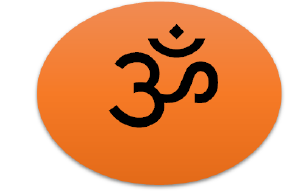Pranava (प्रणवः)
| This article needs editing.
Add and improvise the content from reliable sources. |
Pranava (Samskrit : प्रणवः) is the sound for the most fundamental syllable OM (ॐ). Brahman (the Supreme) is represented by OM (ॐ) or Pranava (प्रणवः) and designated as तत् ॥ That and IT. Brahman (ब्रह्मन्) stands for Unity, which cannot be perceived by the eyes, but which IS (exists सत्) and is implied in the very existence of universes, systems, worlds, and in effect all entities (animate or inanimate).
Called as Pranava naada, it is one syllable that is meditated upon by the sadhakas practicing Paravidya and Upasana. The grhasthas use it in yoga practice and pranayama activities. One may notice that many stotras and praises of deities start with the syllable OM (ॐ).
All Upanishads discuss about Pranava giving different perspectives about how it represents Brahman.
Shvetasvatara Upanishad
यदाऽतमस्तन्न दिवा न रात्रिर्न सन्नचासच्छिव एव केवलः । तदक्षरं तत्सवितुर्वरेण्यं प्रज्ञा च तस्मात्प्रसृता पुराणी ॥ १८ ॥(Shev. Upan. 4.18)[1]
Taittriya Upanishad
Tattriyopanishad, Shikshavalli contains the stuti of Pranava in the eighth anuvaka as follows
ओमिति ब्रह्म । ओमितीदँसर्वम् । (Tait. Upan. 1.8)[2]
ओमित्येकाक्षरं ब्रह्म (Maha. Nara. Upan. 33)
Kathopanishad
Kathopanishad states
सर्वे वेदा यत्पदमामनन्ति तपाँसि सर्वाणि च यद्वदन्ति । यदिच्छन्तो ब्रह्मचर्यं चरन्ति तत्ते पदँ संग्रहेण ब्रवीम्योमित्येतत् ॥ १५ ॥
एतद्ध्येवाक्षरं ब्रह्म एतद्ध्येवाक्षरं परम् । एतद्ध्येवाक्षरं ज्ञात्वा यो यदिच्छति तस्य तत् ॥ १६ ॥ (Kath. Upan. 1.2.15-16)[3]
That which all the Vedas declare, that which all austerities utter, That desiring which they lead the life of Brahmacharya, That Word I tell thee briefly : it is Aum. That Word is even Brahman; that Word is even the Supreme. Knowing that Word, whatever one desires, that becomes his.[4]
Mandukya Upanishad
Mandukya's exposition about Om and Shankaracharya's bhasyam for are given below
ओमित्येतदक्षरमिदँसर्वं तस्योपव्याख्यानभूतं भवद् भविष्यदिति सर्वमोङ्कार एव। यच्चान्यत् त्रिकालातीतं तदप्योङ्कार एव ॥ १ ॥ (Mand. Upan. 1)[5]
Summary : The letter Om is verily all that is. All that is past, present, or future is verily OM. And whatever that is beyond the three time periods is also none other than Omkara. As the supreme Brahman is known through the relationship subsisting between name and object, it too is OM.[6]
References
- ↑ Shvetasvatara Upanishad (Adhyaya 4)
- ↑ Taittriyopanishad (Shikshavalli, Anuvaka 8)
- ↑ Kathopanishad (Adhyaya 1 Valli 2)
- ↑ Sanatana Dharma : An Advanced Textbook of Hindu Religion and Ethics. (1903) Benares : The Board of Trustees, Central Hindu College
- ↑ Mandukya Upanishad (Complete)
- ↑ Swami Gambhirananda (1937) Eight Upanishads, Volume 2 (Aitareya, Mundaka, Mandukya and Karika, and Prasna) With the Commentary of Sankaracarya. Calcutta: Advaita Ashrama. (Pages 179-180)

